|
|
|
Sort Order |
|
|
|
Items / Page
|
|
|
|
|
|
|
| Srl | Item |
| 1 |
ID:
088933


|
|
|
|
|
| Publication |
2009.
|
| Summary/Abstract |
This article addresses the conflict over the Euphrates and Tigris waters from the perspective of negotiation theories, by examining the role of power in upstream/downstream negotiations. Conceptual and empirical links are established between water, negotiation (structure, process), power (asymmetries, coalition dynamics, strategies, development of alternatives) and security (direct/indirect interests such as national security, border security, territorial claims, economic development and environmental concerns). The study concludes that asymmetries in power have favored upstream/downstream interactions towards bilateral if not basin-wide arrangements. The framework shows that traditional elements of power, such as upstream positions, military and economic resources, do not constitute the only sources of power. Bargaining power can also determine the dynamics between respective riparians. Time constitutes an important source of power, and interests vary over time when political settings and security concerns shift. Downstream or more vulnerable riparians can invert situations of power asymmetry by acting on the basin-dominant riparian's interests and thus reduce its alternatives. Syria's use of 'issue-linkage' in its interactions with Turkey over water and wider security issues serves as the primary example.
|
|
|
|
|
|
|
|
|
|
|
|
|
|
|
|
| 2 |
ID:
103247
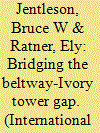

|
|
|
|
|
| Publication |
2011.
|
| Summary/Abstract |
While some gap between the academic and policy worlds is inherent, it is neither necessary nor beneficial for the "Beltway-Ivory Tower" to be as wide as it is. Three principal factors explain the extent of the gap: academia's dominant organizational culture, which devalues policy relevance; increased role of think tanks as research transmission belts to the policy world; and limited interest of the policy community in academic research. The case for the value of greater policy relevance for the international relations scholarly community is based on the intellectual pluralism of bringing policy relevance in while not driving theory out, intellectual complementarity in the different relative strengths of scholars and policy professionals, and self-interest both in what individual scholars can learn and in being true to the mission of universities. We make three principal bridging the gap recommendations: increase disciplinary incentives for policy relevant scholarship, more programmatic and project-based connectivity, and more policy world experiential opportunities.
|
|
|
|
|
|
|
|
|
|
|
|
|
|
|
|
| 3 |
ID:
166984
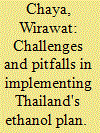

|
|
|
|
|
| Summary/Abstract |
Thailand's ethanol policy is embedded in the Alternative Energy and Development Plan 2015 (AEDP 2015). The policy goal is to increase ethanol production and consumption in 2036 at 223% of the baseline in 2015. A large demand for feedstock supplies, mainly molasses and cassava to meet the policy target causes concerns over their sufficiency. However, oversupply of ethanol has been observed occasionally. Since ethanol production and consumption are relevant to a number of policies, incoherence and gaps may contribute to the shortcomings. By applying a combined coherence and gap analysis, it is shown that crop zoning is irrelevant to and ineffective in securing the supply of ethanol. On the other hand, demand saturation is primarily due to the ineffectiveness of the state mechanisms. Key factors contributing to the problem are low prices of crude oil, high prices of feedstocks, managing availability of and accessibility to certain types of blended fuels in favor of the low blended ones, incorrect understanding of consumers towards high blended fuels and the public's recent interest towards electric vehicles. Political factors may also account for the slow-growing demand. The developed method is proved to be useful in determining effectiveness of interrelated policies dealing with ethanol.
|
|
|
|
|
|
|
|
|
|
|
|
|
|
|
|
| 4 |
ID:
180841
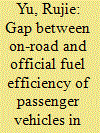

|
|
|
|
|
| Summary/Abstract |
The gap between on-road fuel efficiency and official fuel efficiency of passenger vehicles reported by manufacturers is widening, which would lead to the underestimate of real fuel consumption and biased projection of energy demand in the road transport sector. To investigate the gap between official and on-road fuel efficiency of passenger vehicles, we first built a comprehensive dataset of 393,108 valid observations, including vehicle system parameters, fuel-efficient technology, etc. Then we developed two regression models to quantify the driving factors of the increasing gap and slow improvement in on-road fuel efficiency, and the contribution of each factor to the gap. Results show that the fuel efficiency gap enlarged from 14.4% in 2010 to 25.1% in 2016, and the average on-road fuel efficiency did not have substantial improvement though the official fuel efficiency did. The fuel-efficient technologies have the greatest effect on both the fuel efficiency gap and on-road fuel efficiency among the factors considered in this study. Among the fuel-efficient technologies, hybrid electric vehicle would decrease the ratio of on-road to official fuel efficiency by 12.4% and improve the on-road fuel efficiency by 44.1%. Impacts of other fuel-efficient technologies were also assessed. Further government effort on policies to encourage fuel-efficient technologies for improving real on-road fuel efficiency is needed.
|
|
|
|
|
|
|
|
|
|
|
|
|
|
|
|
| 5 |
ID:
085469
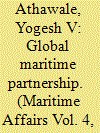

|
|
|
|
|
| Publication |
2008.
|
| Summary/Abstract |
The proposal of maritime partnership (GMP) or the "1,000 -ship navy", floated by the top leadership of the United State Navy (USN) few years ago, signaled an appreciable change in the superpower's maritime strategy for the new century. The present paper traces the genesis of this proposal and elucidates the rationale that could have prompted its conception. The voluntary response presented through the deployment of naval forces by various nations to counter the recent
|
|
|
|
|
|
|
|
|
|
|
|
|
|
|
|
| 6 |
ID:
158064
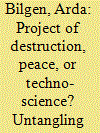

|
|
|
|
|
| Summary/Abstract |
The Southeastern Anatolia Project (Güneydoğu Anadolu Projesi, GAP) was initiated in the 1970s to produce energy and irrigate arid lands through constructing dams and hydroelectric power plants on the Euphrates and Tigris rivers and extensive irrigation networks in southeastern Turkey. Over time, the project was expanded to achieve a wider range of goals in different fields and radically transform Southeastern Anatolia Region. It is also widely claimed that GAP was initiated to address the root causes of the Kurdish question in Turkey and that security considerations and political calculations were actually the raison d’être of GAP. However, this supposed link between GAP and the Kurdish question was often established in a simplistic manner and the question how these two have been related – or not – remained largely untangled. This article aims to fill this research gap and examine the complex and multi-dimensional nature of the interrelationship between GAP and the Kurdish question based on diverse primary and secondary data sources. Accordingly, the article identifies and discusses major narratives in which GAP was conceived as a political and strategic ‘anti-Kurdish’ plot; remedy for the conflict; and totally technical non-political project and presents an alternative and more accurate perspective on how to interpret this relationship.
|
|
|
|
|
|
|
|
|
|
|
|
|
|
|
|
| 7 |
ID:
147945


|
|
|
| 8 |
ID:
175048


|
|
|
|
|
| Summary/Abstract |
The Southeastern Anatolia Project (Güneydoğu Anadolu Projesi, GAP) is one of the largest regional development projects ever implemented in the Middle East. Launched officially in the 1970s to develop the water and land resources of southeastern Turkey, GAP has over time evolved from a predominantly technical, largely state-led and mainly infrastructural and economic development-oriented project into a primarily social, largely market-friendly and chiefly sustainable and human development-oriented project. Parallel to this evolution, GAP has grown more visible in political and public discourses. The implications of the project, for instance, on the ecology and cultural heritages, on the Kurdish Question, and on water issue among Turkey, Syria and Iraq have become clearer. However, despite growing academic and policy interest on GAP, there has been no attempt to provide a literature review on the project. Even more than 40 years after GAP was begun, a bird’s eye view of researched and under-researched topics in the literature has not been introduced yet. This article seeks to present a qualitative review of GAP-related literature. In this way, it seeks to constitute an initial step to establish a base for more expansive reviews and to provide guidance to interested and involved researchers, practitioners and policymakers.
|
|
|
|
|
|
|
|
|
|
|
|
|
|
|
|
|
|
|
|
|